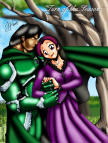









|
Chapter Two English Literature of the Late Medieval
Ages
I. Sir Gawain and Greenknight
 Sir Gawain and Greenknight was written about 1375-1400 by an unknown
poet and it is seen as the most outstanding single romance on the Arthurian
legend in alliterative verse and in the Midland dialect of Middle English
with about 2530 lines. It is about the adventures of Sir Gawain, one of the
chief Arthurian knights, who are usually of noble birth and have military
rank to fight for the king whenever at war. They were expected to have the
virtues of courage, loyalty, bravery and honesty. Their virtues and
devotions to the weak and women are also the code of Chivalry. Then the new
form of literature in verse dealing with the adventures, love stories and
heroic deeds of chivalry called metrical romance was flouring in the Middle
Age. The poem based on the most popular Arthurian romance associated with
the romantic figure of King Arthur.
Sir Gawain and Greenknight was written about 1375-1400 by an unknown
poet and it is seen as the most outstanding single romance on the Arthurian
legend in alliterative verse and in the Midland dialect of Middle English
with about 2530 lines. It is about the adventures of Sir Gawain, one of the
chief Arthurian knights, who are usually of noble birth and have military
rank to fight for the king whenever at war. They were expected to have the
virtues of courage, loyalty, bravery and honesty. Their virtues and
devotions to the weak and women are also the code of Chivalry. Then the new
form of literature in verse dealing with the adventures, love stories and
heroic deeds of chivalry called metrical romance was flouring in the Middle
Age. The poem based on the most popular Arthurian romance associated with
the romantic figure of King Arthur.
Sir Gawain and Greenknight contains four “fits’(sections).
In the first fit, when King Arthur and all his knights of the Round Table
are celebrating Christmas at Camelot, Suddenly, a giant knight clothed all
in green and riding a green horse, breaks in. This green giant carries
neither spear nor shield but a big sharp axe. He challenges to them to
strike him a blow with the axe first and then receive a return blow at the
same time of the next year. Sir Gawain accepts the challenge and lets fall
the axe and chops off the heads of the Green Knight, bur the giant picks up
his head and speaks to Gawain, appointing to meet him at the Green Chapel in
North Wales for the return blow the next year morning. In the second fit,
King Arthur holds a feast to send Gawain off. Gawain departs riding on his
horse through many dangerous places like cliffs fords and on his journey he
meets with all sort of adventures with wild animals and savages. Later, he
comes into a gloomy forest of many oaks and sees a castle. He is well
entertained by the lord and a lady, more beautiful than the queen, of the
castle. Hearing the Green Chapel is no more than two miles away, Gawain
agrees to stay on the caste till the New Year’s Day. To offer friendship,
the guest and the host agree to exchange what they gain during the day for
each day of his stay at the castle. The third fit tells what happens during
Gawain’ stay at the castle. On the first day, the lord goes hunting and
kills many deer while the fair lady comes to seduce Gawain, but Gawain does
not to give way to temptation and only let her kiss him once. At night, the
host gives Gawain the deer and Gawain gives him a kiss. The second day, the
lady fails to seduce Gawain and only is allowed to kiss him once and at
night the host gives Gawain the shields of the boar and Gawain again kisses
the host. The third day, the host hunts a fox and the lady kisses him and
offered Gawain a gold ring but refused by him. Finally, Gawain receives the
girdle, because the lady tells him that the girdle can protect him from
harm. As night comes, Gawain gives the host only the kisses and keeps the
girdle for himself. In the four fit, Gawain goes to the Green Chapel on New
Year’s Day according to the appointment. He finds an old cave and the Green
Knight appears. The Green Knight wounds him during the second blow and makes
him known that he is the host of the castle and that lady, who planed to
seduce Gawain, is his wife and the wound is the punishment for concealing
the “magic” girdle. Gawain feels a deep shame on his cowardice and
covetousness and gives back the girdle, but the Green Night forgives him and
compliments him. When Gawain returns to his native land, he tells his
adventures and also his shame on the girdle. In order to comfort and honor
him, all knights begin to wear a green belt
The poem eulogizes the ideal of feudal knighthood with
the virtues of great courage, of fidelity to the promise, and of chastity
and purity through the blow match between Sir Gawain and Green Knight and
failure of the lady’s temptation.
This poem is a wonderful example of the wisdom of the
minstrels of the Middle Age and this romance is well told in beautiful
poetry with many artistic merits.

|
![]()
![]()